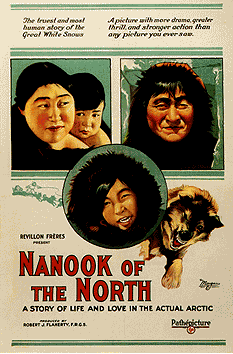
"Nanook of the north" é considerado o início da história do documentário. O filme mudo de Robert J. Flaherty, elaborado em 1922, apresenta-nos um ano da vida de um esquimó completamente alheio à vida industrial, vivendo essencialmente da caça, da pesca e de algum comércio. No texto "How I Filmed "Nanook of the North", Flaherty conta como foi despertado para a arte que, a exemplo do jornalismo, procura coleccionar fragmentos do real. Ele conta assim a sua jornada antropológica de conhecimento do Outro:
"In August 1910, Sir William MacKenzie whose transcontinental railway, the Canadian Northern, was then in the initial stages of construction, commissioned the writer to undertake an expedition to the East Coast of Hudson Bay to examine deposits of certain islands upon which iron ore were supposed to be located. […]
As a part of my exploration equipment, on these expeditions, a motion-picture outfit was included. It was hoped to secure films of the North and Eskimo life, which might prove to be of enough value to help in some way to defray some of the costs of the explorations.

While wintering in Baffin Land during 1913-14 films of the country and the natives were made as was also done on the succeeding expedition to the Belcher Islands. The film, in all, about 30,000 feet, was brought out safely, at the conclusion of the explorations, to Toronto, where, while editing the material, I had the misfortune of losing it all by fire. Though it seemed to be a tragedy at the time, I am not sure but what it was a bit of fortune that it did burn, for it was amateurish enough."
O fogo que consumiu estes primeiros registos de Flaherty acabou por deixá-lo cada vez mais interessado em filmes. Ele explica assim:
"New forms of travel film were coming out and the Johnson South Sea Island film particularly seemed to me to be an earnest of what might be done in the North. I began to believe that a good film depicting the Eskimo and his fight for existence in the dramatically barren North might be well worth while. To make a long story short, I decided to go north again- this time wholly for the purpose of making films."
O projecto acabou por ter o financiamento dos Revillon Freres (como se pode ver no cartaz original do filme, no topo desta mensagem). No dia 18 de Junho de 1920, o realizador partir novamente para as terras frias. Como equipamento levava 75 mil pés de rolo de filmes (não sei converter esta medida, peço desculpas), um projector, holofotes Haulberg, duas câmaras Akeley e ainda uma impressora que permitia identificar eventuais falhas técnicas durante as filmagens. Nesta expedição, conheceu Nanook, um esquimó adorável. Juntos, enfrentaram obstáculos como a falta de comida e o confronto com os desmandos da natureza - algo que os aproximou profundamente e permitiu a cumplicidade necessária para a realização do documentário. Criou-se o elo necessário para a existência daquele que "rouba" a imagem do outro e, por extensão, daquele que se deixa retratar. No fim do seu relato, Flaherty diz que "it was not all loss: I was richer by a fuller knowledge of the fine qualities of my sterling friends, the Eskimos."
PS. Não me perguntem porque, mas "Nanook of the North" me faz lembrar um outro filme, o "Dersu Uzala" (Kurosawa, 1975). Nunca esqueci a parte em que o protagonista – também ele na pele do Outro – considera imponderável (é o que nos revela o seu olhar) que se possa vender a água, algo tão elementar à vida humana. Ele via água como um direito.
Sem comentários:
Enviar um comentário